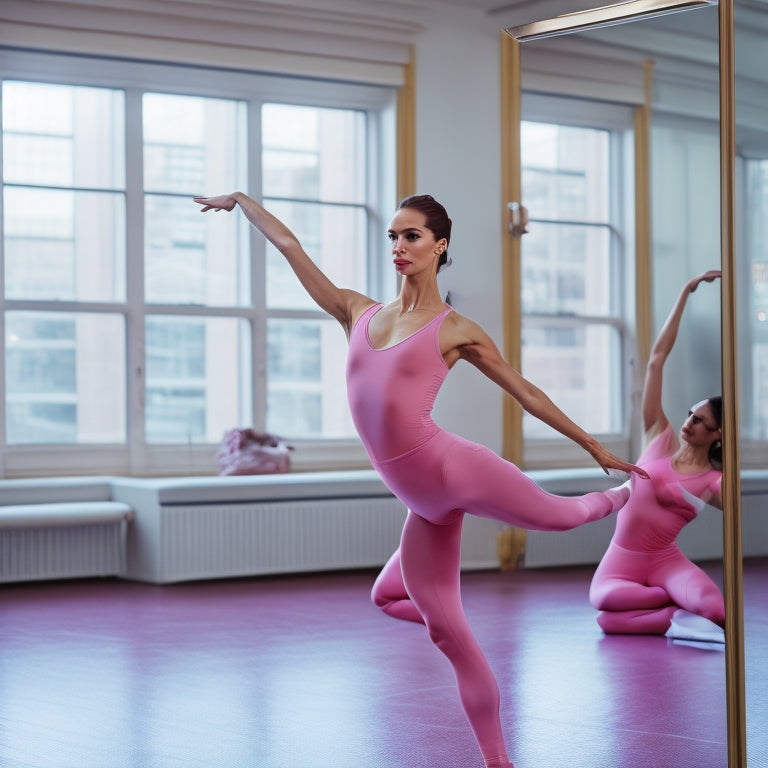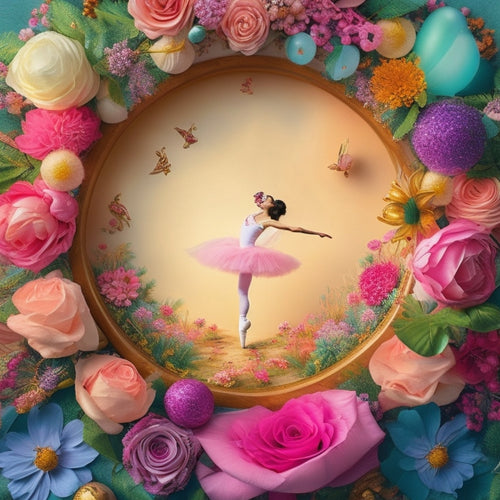
Dance Practice Wear Picks for Maximum Comfort and Performance
Share
When choosing dance practice wear, you want gear that optimizes comfort and performance. Opt for moisture-wicking fabrics that draw sweat away from your skin, regulate body temperature, and prevent irritation. Look for quick-drying properties that manage sweat and dry swiftly, and four-way stretch technology that allows for maximum flexibility. Seamless construction can reduce friction points, minimizing chafing and enhancing muscle memory. Considering your specific dance style is also essential - breathable fabrics and muscle recovery-enhancing compression garments can make a significant difference. By understanding the key factors, you'll find the perfect gear to boost your performance.
What You Need to Know
- Choose moisture-wicking fabrics to manage sweat and regulate body temperature during intense dance sessions.
- Quick-drying properties in fabrics help maintain ideal body temperature and prevent overheating.
- Four-way stretch technology allows fabrics to stretch in all directions for maximum flexibility and performance.
- Seamless construction benefits dancers by reducing friction points and minimizing chafing during high-impact movements.
- Consider compression garments for muscle recovery enhancement by improving blood flow and reducing swelling.
Moisture-Wicking Fabric Matters
When you're choosing dance practice wear, it's crucial to take into account the fabric's ability to manage moisture.
Look for breathable base layers that allow air to circulate and help regulate your body temperature. Opting for quick-drying properties in your dance wear will also help keep you dry and comfortable during intense practice sessions.
Additionally, moisture-wicking technology is a must-have feature, as it effectively manages sweat during intense sessions, allowing dancers to focus on their moves without feeling weighed down, such as Moisture-Wicking Technology.
Furthermore, four-way stretch fabric allows for unrestricted movement, enhancing flexibility and performance.
Breathable Base Layers
In the pursuit of ideal dance performance, an important aspect often overlooked is the choice of base layers. When selecting breathable base layers, it's vital to take into account fabric breathability and layering techniques.
Look for base layers made from technical fabrics like mesh panels, polyester blends, or merino wool. These fabrics allow for airflow and moisture transfer, keeping you cool and dry during intense dance sessions.
When choosing base layers, reflect on the type of dance you'll be performing. For high-intensity styles like hip-hop or contemporary, opt for lightweight, breathable tops and leggings or tights.
For lower-intensity styles like ballet or modern, you may prefer a slightly thicker base layer for added warmth. Layering techniques are also key – a breathable base layer can be paired with a mid-layer for added warmth or a lightweight outer layer for protection from the elements.
Quick-Drying Properties
Beyond the foundation of breathable base layers lies another crucial aspect: quick-drying properties. You need fabrics that can efficiently manage sweat and dry swiftly to keep you comfortable during intense dance practices. Moisture-wicking fabric matters in this regard, as it's designed to draw sweat away from your skin and evaporate it quickly.
When choosing dance practice wear, look for fabrics with advanced sweat management systems. These fabrics typically feature a blend of synthetic and natural fibers, such as polyester, nylon, or spandex, which work together to wick moisture and dry rapidly. This technology helps maintain your body's ideal temperature and prevents overheating.
Quick-drying properties also contribute to fabric durability. When sweat is allowed to linger, it can weaken fibers and reduce the garment's lifespan. By choosing dance wear with moisture-wicking fabric, you're not only ensuring a more comfortable practice but also extending the life of your garment.
This freedom to move and perform without restriction is essential for dancers, and the right quick-drying properties can make all the difference in your practice. Opt for fabrics that balance sweat management with durability to maximize your performance and comfort.
Boosts Muscle Recovery Time
When you wear dance practice clothing that enhances muscle recovery time, you're taking an essential step towards optimizing your body's repair process.
By reducing muscle inflammation, you're creating an environment that encourages faster repair, which can get you back to peak performance sooner. This can be achieved by incorporating moisture-wicking fabrics breathable materials that draw sweat away from skin, enhancing evaporation and preventing sweat buildup, which can hinder movement.
Compression and graduated compression garments, in particular, have been shown to improve blood flow and reduce swelling, key factors in accelerating muscle recovery.
Reduced Muscle Inflammation
Compression and moisture-wicking fabrics in dance practice wear play an essential role in reducing muscle inflammation, a significant factor in enhancing muscle recovery time.
When you dance, your muscles experience micro-tears, which can lead to inflammation. Wearing clothes with compression properties helps improve blood flow, reducing inflammation and promoting muscle recovery.
Moisture-wicking fabrics also aid in this process by drawing sweat away from your skin, preventing irritation and discomfort that can exacerbate inflammation.
Inflammation reduction is important for ideal muscle recovery. When inflammation is reduced, your muscles can recover more efficiently, allowing you to get back to your dance practice sooner.
By choosing dance practice wear that combines compression and moisture-wicking fabrics, you're taking a proactive approach to muscle recovery. This enables you to perform at your best, without the burden of prolonged recovery times.
Faster Repair Process
You're likely no stranger to the physical demands of dance, which can leave your muscles feeling fatigued and sore. To speed up your recovery time, it's crucial to incorporate clothes that aid in the repair process. This is where compression wear comes in - it helps increase blood flow and reduce muscle oscillation, allowing your muscles to repair faster.
Look for clothes made from high-quality, breathable fabrics that promote moisture-wicking properties to keep you dry and comfortable.
Compression wear isn't just beneficial for recovery; it also enhances performance. By providing graduated compression, it helps improve circulation and reduce muscle fatigue. This means you can dance for longer without feeling weighed down.
When choosing compression wear, consider clothes with four-way stretch for maximum flexibility and fabric longevity. This type of fabric allows for a full range of motion, reducing the risk of injury and wear and tear on your clothes.
Four-Way Stretch Technology Explained
When you choose dance practice wear with four-way stretch technology, you're looking at key fabric components that contribute to its flexibility.
These components typically include a combination of polyester, nylon, or spandex, which work together to allow the fabric to stretch in all directions.
Breathable fabrics, such as those discussed in dancewear essentials, play an essential role in maintaining comfort during intense activities.
Key Fabric Components
Embracing four-way stretch technology, modern dance practice wear often boasts fabrics that move with you in every direction.
When choosing your dance practice wear, you want to prioritize key fabric components that provide both comfort and performance. One significant aspect to take into account is fabric durability. A durable fabric guarantees that your gear can withstand repeated wear and tear, including sweat and friction.
Look for fabrics with a high abrasion resistance and tear strength to minimize the risk of damage.
Another vital factor is color retention. You don't want your lively dance wear to fade quickly, compromising its aesthetic appeal.
Opt for fabrics that have undergone specialized colorfast treatments to minimize color bleeding and fading. These treatments help retain the fabric's original color, even after repeated washing and exposure to sunlight.
Stretch and Recovery
Four-way stretch technology is a key component of modern dance practice wear, allowing for uninhibited movement in every direction. This innovative textile design enables you to move freely, without restriction, as you shift between dance styles or intensify your practice.
When you're wearing four-way stretch dance wear, you can focus on perfecting your technique, not worrying about your clothes holding you back.
Four-way stretch technology gets its name from its ability to stretch in all directions – horizontally, vertically, and diagonally. This fabric design provides a full range of motion, making it ideal for active recovery and flexibility training.
Whether you're doing yoga, Pilates, or ballet, you need to be able to move your body freely. Four-way stretch dance wear gives you the freedom to do just that.
By incorporating this technology into your practice wear, you can enhance your performance, improve your flexibility, and reduce your risk of injury.
With four-way stretch dance wear, you can move with confidence and precision, taking your dance practice to the next level.
Consider Your Dance Style
When selecting dance practice wear, it's vital that you consider your dance style to guarantee you're getting the right gear.
For ballet and ballroom dancers, you'll need attire that provides a full range of motion, particularly in the arms and legs, while also maintaining a precise fit. Moreover, incorporating breathable fabrics, such as Mesh Fabrics, can greatly enhance comfort during lively movements.
In addition, consider fabrics with moisture-wicking properties to keep skin dry, reducing skin irritation caused by sweat accumulation.
In contrast, jazz and contemporary dancers may prioritize flexibility and freedom of movement in their clothing choices.
Ballet and Ballroom
Your ballet or ballroom dance practice requires precision and control, which is why the right practice wear is essential.
For ballet, you'll want to focus on finding a leotard that provides a full range of motion and support. Look for one made from a breathable, moisture-wicking fabric that will keep you cool and dry during intense practice sessions. Pair this with a pair of ballet shoes that fit snugly and provide the right amount of support for your feet.
For ballroom dance, you'll want to choose a practice wear that allows for freedom of movement while also accentuating your lines and posture.
Ballroom dresses are a great option, as they provide a full range of motion and can help you develop the posture and frame required for ballroom dance. Look for a dress made from a lightweight, flowing fabric that won't catch on your partner's clothing during practice.
Make sure it's also breathable and moisture-wicking to keep you cool and dry. With the right practice wear, you'll be able to focus on perfecting your technique and performing at your best.
Jazz and Contemporary
Jazz and contemporary dance styles require a focus on energetic movements and fluid expression. When it comes to choosing dance practice wear for these styles, you'll want to prioritize comfort, flexibility, and freedom of movement. Look for clothing that allows for a full range of motion, such as stretchy tops and leggings or jazz pants.
| Feature | Recommendation |
|---|---|
| Fabric | Choose moisture-wicking fabrics, such as polyester or nylon, to keep you dry and comfortable during intense practice sessions. |
| Style | Opt for fitted tops and leggings or jazz pants that provide support and flexibility. |
| Footwear | Select shoes with a non-marking sole, such as jazz shoes or sneakers, to allow for smooth movements and turns. |
| Additional Support | Consider adding a sports bra or dance belt for extra support and stability during high-energy movements. |
When selecting dance practice wear for jazz techniques and contemporary choreography, consider the specific demands of your dance style. For example, if you're focusing on jazz techniques, you may want to prioritize shoes with a sturdy sole for added support.
Seamless Construction Reduces Chafing
When selecting dance practice wear, you should prioritize seamless construction to eliminate friction points that can cause chafing. By opting for garments with bonded seams or welded joints, you can reduce the risk of irritation and discomfort that often accompanies repetitive movements.
Incorporating this feature into your dance attire is especially important for high-impact movements, such as those involved in Dynamic Stretching exercises. Additionally, seamless construction can help improve overall muscle memory by allowing for a full range of motion.
This design feature provides you with chafe-free movement freedom, enabling you to focus on perfecting your technique without distractions.
Chafe-Free Movement Freedom
Seamless construction in dance practice wear is a revolutionary development for dancers who've struggled with painful chafing. When you're not restricted by discomfort or friction, you can focus on perfecting your choreography flexibility and movement aesthetics.
Chafe-free movement freedom allows you to execute intricate steps and maintain fluid shifts between movements, elevating your overall performance. Seamless construction reduces chafing by eliminating seams that can cause friction and irritation. This means you can practice for hours without worrying about discomfort or restricted movement.
In addition, seamless construction provides a full range of motion, allowing you to move freely and naturally. This freedom of movement is essential for dancers who need to express themselves through movement.
When choosing dance practice wear with seamless construction, look for garments made from moisture-wicking, breathable fabrics that will keep you cool and dry during intense practice sessions. A well-designed seamless construction will provide you with the comfort and flexibility you need to perfect your craft.
Frequently Asked Questions
Can I Wear Dance Practice Wear for Casual Outings?
You can definitely wear dance practice wear for casual outings, thanks to versatile styling that aligns with current fashion trends, offering you the freedom to move and express yourself without restrictions, both on and off the dance floor.
How Often Should I Wash Dance Practice Wear?
You're probably wearing those dance practice clothes more often than you'd like to admit, but don't worry, we won't judge. To keep them fresh, wash them after 3-5 wearings, considering fabric care to maintain their quality.
Are Dance Practice Wear and Athletic Wear the Same?
You shouldn't assume dance practice wear and athletic wear are the same. Consider fabric differences, such as moisture-wicking and breathability, and fit considerations like flexibility and compression to choose the best option for your needs.
Can I Wear Jewelry With Dance Practice Wear?
You're moving fluidly, lost in the rhythm, but a flicker of doubt emerges - can you wear jewelry with dance practice wear? Opt for minimalist jewelry types, avoiding anything that may cause safety concerns, like loose earrings or chunky necklaces.
Are Dance Practice Wear Suitable for Outdoor Activities?
You're wondering if your go-to workout gear is suitable for outdoor activities. Most dance practice wear features breathable fabrics and moisture-wicking technology, making them perfect for hiking, running, or other outdoor activities that require flexibility and dryness.
Explore More
You've spent hours perfecting your plié, yet your worn-out dance clothes are hindering your performance. It's time to step up your practice wear game. With moisture-wicking fabrics, four-way stretch technology, and seamless construction, you'll be dancing like a pro in no time. Who needs perfect technique when you're stuck with restrictive, sweat-soaked clothes? Invest in the right gear and let your skills shine through – not your sweat stains.
Related Posts
-

Pawsitively Perfect: Master Lifelike Pet Portraits Now
You're on the verge of capturing the essence of your furry friends like never before! With the right techniques, you'...
-

Ballet Cut File Set: Versatile Designs Available
The Ballet Cut File Set offers a wide-ranging collection of versatile designs available in multiple formats, includin...

